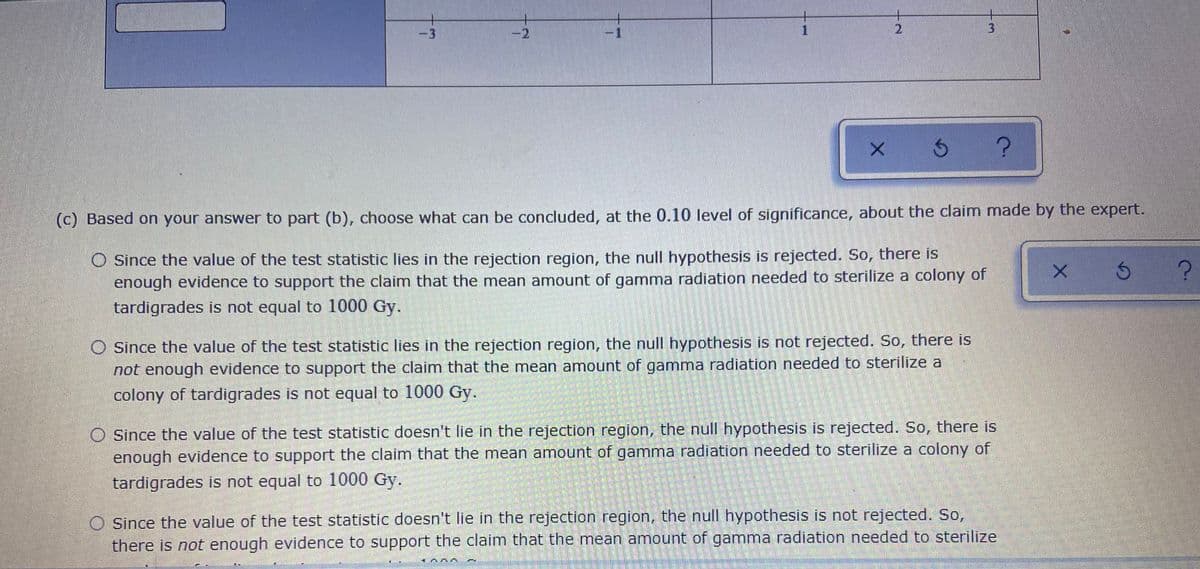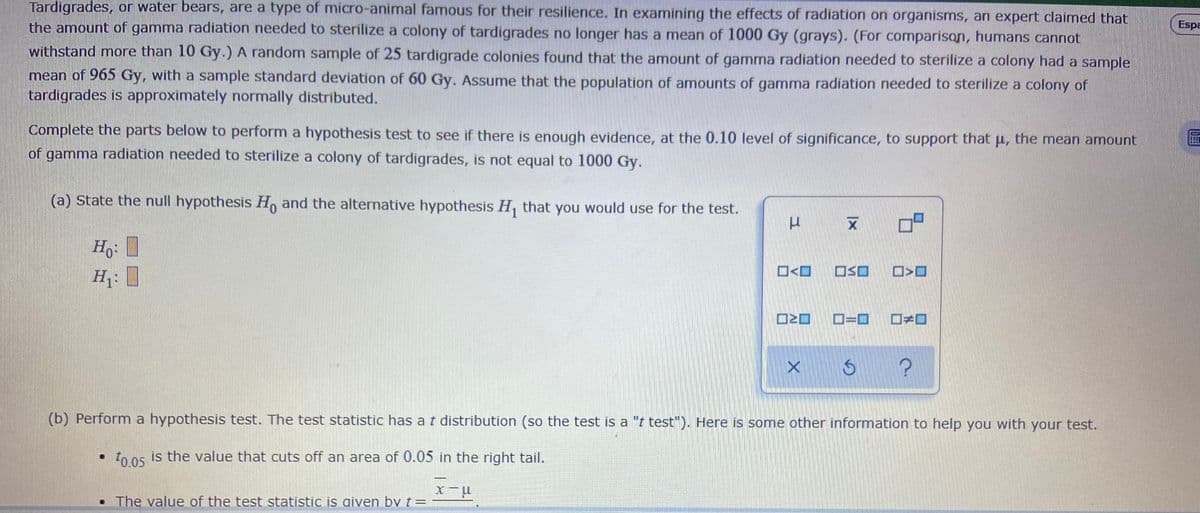Tardigrades, or water bears, are a type of micro-animal famous for their resilience. In examining the effects of radiation on organisms, an expert claimed that the amount of gamma radiation needed to sterilize a colony of tardigrades no longer has a mean of 1000 Gy (grays). (For comparison, humans cannot withstand more than 10 Gy.) A random sample of 25 tardigrade colonies found that the amount of gamma radiation needed to sterilize a colony had a sample mean of 965 Gy, with a sample standard deviation of 60 Gy. Assume that the population of amounts of gamma radiation needed to sterilize a colony of tardigrades is approximately normally distributed. Espe Complete the parts below to perform a hypothesis test to see if there is enough evidence, at the 0.10 level of significance, to support that u, the mean amount of gamma radiation needed to sterilize a colony of tardigrades, is not equal to 1000 Gy. (a) State the null hypothesis H, and the alternative hypothesis H, that you would use for the test. O
Tardigrades, or water bears, are a type of micro-animal famous for their resilience. In examining the effects of radiation on organisms, an expert claimed that the amount of gamma radiation needed to sterilize a colony of tardigrades no longer has a mean of 1000 Gy (grays). (For comparison, humans cannot withstand more than 10 Gy.) A random sample of 25 tardigrade colonies found that the amount of gamma radiation needed to sterilize a colony had a sample mean of 965 Gy, with a sample standard deviation of 60 Gy. Assume that the population of amounts of gamma radiation needed to sterilize a colony of tardigrades is approximately normally distributed. Espe Complete the parts below to perform a hypothesis test to see if there is enough evidence, at the 0.10 level of significance, to support that u, the mean amount of gamma radiation needed to sterilize a colony of tardigrades, is not equal to 1000 Gy. (a) State the null hypothesis H, and the alternative hypothesis H, that you would use for the test. O
Linear Algebra: A Modern Introduction
4th Edition
ISBN:9781285463247
Author:David Poole
Publisher:David Poole
Chapter7: Distance And Approximation
Section7.3: Least Squares Approximation
Problem 31EQ
Related questions
Question

Transcribed Image Text:-3
1
3
(C) Based on your answer to part (b), choose what can be concluded, at the 0.10 level of significance, about the claim made by the expert.
O Since the value of the test statistic lies in the rejection region, the null hypothesis is rejected. So, there is
enough evidence to support the claim that the mean amount of gamma radiation needed to sterilize a colony of
tardigrades is not equal to 1000 Gy.
O Since the value of the test statistic lies in the rejection region, the null hypothesis is not rejected. So, there is
not enough evidence to support the claim that the mean amount of gamma radiation needed to sterilize a
colony of tardigrades is not equal to 1000 Gy.
O Since the value of the test statistic doesn't lie in the rejection region, the null hypothesis is rejected. So, there is
enough evidence to support the claim that the mean amount of gamma radiation needed to sterilize a colony of
tardigrades is not equal to 1000 Gy.
Since the value of the test statistic doesn't lie in the rejection region, the null hypothesis is not rejected. So,
there is not enough evidence to support the claim that the mean amount of gamma radiation needed to sterilize

Transcribed Image Text:Tardigrades, or water bears, are a type of micro-animal famous for their resilience. In examining the effects of radiation on organisms, an expert claimed that
the amount of gamma radiation needed to sterilize a colony of tardigrades no longer has a mean of 1000 Gy (grays). (For comparison, humans cannot
Espe
withstand more than 10 Gy.) A random sample of 25 tardigrade colonies found that the amount of gamma radiation needed to sterilize a colony had a sample
mean of 965 Gy, with a sample standard deviation of 60 Gy. Assume that the population of amounts of gamma radiation needed to sterilize a colony of
tardigrades is approximately normally distributed.
Complete the parts below to perform a hypothesis test to see if there is enough evidence, at the 0.10 level of significance, to support that u, the mean amount
of gamma radiation needed to sterilize a colony of tardigrades, is not equal to 1000 Gy.
(a) State the null hypothesis H, and the alternative hypothesis H, that you would use for the test.
Ho:
(b) Perform a hypothesis test. The test statistic has a t distribution (so the test is a "t test"). Here is some other information to help you with your test.
In o5 is the value that cuts off an area of 0.05 in the right tail.
fo.05
O The value of the test statistic is aiven bv t =
Expert Solution
This question has been solved!
Explore an expertly crafted, step-by-step solution for a thorough understanding of key concepts.
This is a popular solution!
Trending now
This is a popular solution!
Step by step
Solved in 2 steps with 1 images

Recommended textbooks for you

Linear Algebra: A Modern Introduction
Algebra
ISBN:
9781285463247
Author:
David Poole
Publisher:
Cengage Learning

Glencoe Algebra 1, Student Edition, 9780079039897…
Algebra
ISBN:
9780079039897
Author:
Carter
Publisher:
McGraw Hill

Linear Algebra: A Modern Introduction
Algebra
ISBN:
9781285463247
Author:
David Poole
Publisher:
Cengage Learning

Glencoe Algebra 1, Student Edition, 9780079039897…
Algebra
ISBN:
9780079039897
Author:
Carter
Publisher:
McGraw Hill